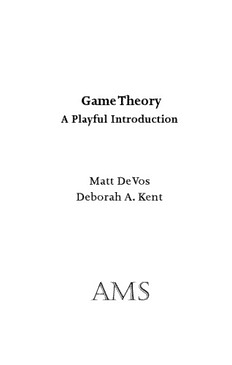
Game Theory. A playful Introduction PDF
Preview Game Theory. A playful Introduction
Game Theory A Playful Introduction Matt DeVos Deborah A. Kent 2010MathematicsSubjectClassification.Primary91-01,91A46,91A06,91B06. Foradditionalinformationandupdatesonthisbook,visit www.ams.org/bookpages/stml-80 LibraryofCongressCataloging-in-PublicationData Names:DeVos,MatthewJared,1974-jKent,DeborahA.,1978- Title:Gametheory:aplayfulintroduction/MatthewDeVos,DeborahA.Kent. Description:Providence,RhodeIsland:AmericanMathematicalSociety,[2016]jSeries: Studentmathematicallibrary; volume80jIncludesbibliographicalreferencesand index. Identifiers:LCCN2016035452jISBN9781470422103(alk.paper) Subjects: LCSH:Gametheory–Textbooks. jCombinatorialanalysis–Textbooks. jAMS: Game theory, economics, social and behavioral sciences – Instructional exposition (textbooks,tutorialpapers,etc.).mscjGametheory,economics,socialandbehavioral sciences–Gametheory–Combinatorialgames.mscjGametheory,economics,social andbehavioralsciences–Gametheory–n-persongames,n > 2. mscjGamethe- ory,economics,socialandbehavioralsciences–Mathematicaleconomics–Decision theory.msc Classification: LCC QA269 .D45 2016 j DDC 519.3–dc23 LC record available at https://lccn.loc.gov/2016035452 ©2016bytheAmericanMathematicalSociety PrintedintheUnitedStatesofAmerica. VisittheAMShomepageathttp://www.ams.org/ Contents Preface xi Chapter1. CombinatorialGames 1 §1.1. GameTrees 3 §1.2. Zermelo’sTheorem 9 §1.3. Strategy 14 Exercises 19 Chapter2. Normal-PlayGames 25 §2.1. PositionsandTheirTypes 27 §2.2. SumsofPositions 30 §2.3. Equivalence 36 Exercises 41 Chapter3. ImpartialGames 45 §3.1. Nim 46 §3.2. TheSprague-GrundyTheorem 52 §3.3. ApplyingtheMEXPrinciple 54 Exercises 59 Chapter4. HackenbushandPartizanGames 63 §4.1. Hackenbush 64 §4.2. DyadicNumbersandPositions 71 §4.3. TheSimplicityPrinciple 77 Exercises 83 Chapter5. Zero-SumMatrixGames 89 §5.1. Dominance 91 §5.2. MixedStrategies 95 §5.3. VonNeumannSolutions 100 Exercises 104 Chapter6. VonNeumann’sMinimaxTheorem 111 §6.1. EquatingtheOpponent’sResults 113 §6.2. Two-DimensionalGames 118 §6.3. ProofoftheMinimaxTheorem 123 Exercises 128 Chapter7. GeneralGames 133 §7.1. Utility 135 §7.2. MatrixGames 139 §7.3. GameTrees 145 §7.4. Treesvs.Matrices 150 Exercises 155 Chapter8. NashEquilibriumandApplications 161 §8.1. NashEquilibrium 162 §8.2. EvolutionaryBiology 169 §8.3. CournotDuopoly 176 Exercises 182 Chapter9. Nash’sEquilibriumTheorem 187 §9.1. Sperner’sLemma 189 §9.2. Brouwer’sFixedPointTheorem 192 §9.3. StrategySpaces 198 §9.4. NashFlowandtheProof 202 Exercises 208 Chapter10. Cooperation 213 §10.1. TheNegotiationSet 214 §10.2. NashArbitration 221 §10.3. RepeatedGamesandtheFolkTheorem 228 Exercises 238 Chapter11. 𝑛-PlayerGames 245 §11.1. MatrixGames 247 §11.2. Coalitions 251 §11.3. ShapleyValue 260 Exercises 270 Chapter12. PreferencesandSociety 275 §12.1. FairDivision 277 §12.2. StableMarriages 285 §12.3. Arrow’sImpossibilityTheorem 290 Exercises 298 AppendixA. OnGamesandNumbers 301 AppendixB. LinearProgramming 309 BasicTheory 310 AConnectiontoGameTheory 313 LPDuality 317 AppendixC. NashEquilibriuminHighDimensions 323 GameBoards 331 Bibliography 335 IndexofGames 339 Index 341 Preface Thestoryofthisbookbeganin2002whenMatt,thenapostdocatPrince- ton University, was given the opportunity to teach an undergraduate classingametheory. Thankslargelytothe2001releaseofaHollywood movieonthelifeofthefamousPrincetonmathematicianand(classical) gametheoristJohnNash,thiscourseattractedalargeandhighlydiverse audience. Princeton’smathematicsdepartmentfeaturednotonlyNash, butalsoJohnConway,thefatherofmoderncombinatorialgametheory. Soitseemedonlynaturaltoblendthetwosidesofgametheory,combi- natorialandclassical,intoone(ratherambitious)class.Thevariedback- groundsofthestudentsandthelackofasuitabletextbookmadeforan extremelychallengingteachingassignment(thatsometimeswentawry). However,thesimplefunofplayinggames,therichmathematicalbeauty ofgametheory,anditssignificantreal-worldconnectionsstillmadefor anamazingclass. Deborahadoptedavariantofthismaterialafewyearslaterandfur- therdevelopeditforageneralundergraduateaudience. Overtheensu- ingyears,DeborahandMatthavebothtaughtnumerousincarnationsof thiscourseatvariousuniversities.Throughexchangeandcollaboration, thematerialhasundergoneathoroughevolution,andthistextbookrep- resentstheculminationofourprocess. Wehopeitwillprovideanintro- ductorycourseinmathematicalgametheorythatyouwillfindinviting, entertaining,mathematicallyinteresting,andmeaningful. Combinatorial game theory is the study of games like Chess and Checkersinwhichtwoopponentsalternatemoves, eachtryingtowin thegame. Thispartofgametheoryfocusesondeterministicgameswith fullinformationandisthushighlyamenabletorecursiveanalysis.Com- binatorialgametheorytracesitsrootstoCharlesBouton’stheoryofthe game Nim and a classification theorem attributed independently to RolandSpragueandPatrickGrundy. The1982publicationoftheclassic WinningWaysforYourMathematicalPlaysbyElwynBerlekamp,John Conway, and Richard Guy laid a modern foundation for the subject— nowathrivingbranchofcombinatorics. Incontrast,classicalgamethe- oryisanaspectofappliedmathematicsfrequentlytaughtindepartments of economics. Classical game theory is the study of strategic decision- making in situations with two or more players, each of whom may af- fecttheoutcome. JohnvonNeumannandOskarMorgensternarecom- monly credited with the foundation of classical game theory in their groundbreakingworkTheoryofGamesandEconomicBehaviorpublished in1944. Thistreatiseestablishedabroadmathematicalframeworkfor reasoningaboutrationaldecision-makinginawidevarietyofcontexts anditlaunchedanewbranchofacademicstudy. Althoughtherehave been many significant developments in this theory, John Nash merits mention for his mathematical contributions, most notably the Nash EquilibriumTheorem. Traditionally,theclassicalandcombinatorialsidesofgametheory are separated in the classroom. A strong theme of strategic thinking nonetheless connects them and we have found the combination to re- sultin a rich and engagingclass. The greatfun wehavehad teaching thisbroadmathematicaltourthroughgametheoryundergirdedourde- cision towrite this book. Fromthe verybeginning of this project, our goalhasbeentogiveanhonestintroductiontothemathematicsofgame theory(bothcombinatorialandclassical)thatisaccessibletoanearlyun- dergraduatestudent. Overtheyears,wehavedevelopedanapproachto teachingcombinatorialgametheorythatavoidssomeoftheset-theoretic complexitiesfoundinadvancedtreatmentsyetstillholdstruetothesub- ject.Asaresult,weachievethetwocornerstonesoftheSprague-Grundy TheoremandtheSimplicityPrincipleinanefficientandstudent-friendly manner. Theclassicalgametheoryportionofthebookcontainsnumer- ouscarefullysculptedandeasy-to-followproofstoestablishthetheoret- icalcoreofthesubject(includingtheMinimaxTheorem,Nasharbitra- tion,ShapleyValue,andArrow’sParadox). Mostsignificantly,Chapter 9isentirelydevotedtoanextremelygentleproofofNash’sEquilibrium Theorem. For the sake of concreteness, the chapter focuses on 2 × 2 matrices,buteachargumentgeneralizesandAppendixCcontainsfull details. Sperner’sLemmaappearsinthischapterasthefirststepofour proofandweofferanintuitiveexpositionofthislemmabytreatingitas a game of solitaire. More broadly, Sperner’s Lemma provides a touch- stone through other chapters. In addition to using it to prove Nash’s EquilibriumTheorem,wealsocallonittoshowthatthecombinatorial gameHexcannotendinadraw. Laterstill,Sperner’sLemmaallowsus toconstructanenvy-freedivisionofcake. Beyondincludingbothcombinatorialandclassicaltheory,wehave soughttoprovideabroadoverviewof(bothsidesof)thesubject.Within theworldofcombinatorialgametheory,webeginataveryhighlevelof generality with game trees and Zermelo’s Theorem—concepts that ap- plytoChess,Checkers,andmanyother2-playergames. Wealsointro- ducesomewidelyapplicableideassuchassymmetryandstrategysteal- ingbeforespecializinginnormal-playgamestodeveloptheheartofthe theory. Ontheclassicalside,inadditiontotheessentialmathematical concepts, wetouravarietyofexcitingsupplementarytopicsincluding theFolkTheorem,cakecutting,andstablemarriages. Furthermore,we havedevotedconsiderableefforttoconnectingthetheorywithapplica- tions. Chapter7focusesonthemodelingcapabilityofagame-theoretic frameworkinthecontextofsports,biology,business,politics,andmore! Oneofourprimarygoalsinthisbookistoenhancethemathemat- icaldevelopmentofourstudentreaders. Indeed,weaimtotakeadvan- tageofthenaturallystimulatingsubjectofgametheorytoteachmathe- matics. Wehavefoundthatblendingcombinatorialandclassicalgame theoryhasgreatpedagogicaladvantages. Beginningwithcombinatorial games means that student pairs are playing and recursively analyzing games right from the start. These games are not only fun to play, but theyprovideaperfectenvironmentforworkingwithgametrees, prov- ingtheoremsbyinduction,andstartingtothinkstrategically. Thispart ofthebookfeaturesnumerousrichexamplesofproofsbyinductionand also a number of interesting proofs by contradiction. Turning to clas- sical game theory, we encounter basic probability, linear algebra, and convexityinourstudyofzero-summatrixgames. Ourlaterchapterson generalgamescontinuetoemphasizeprobabilityandgeometricmeth- odsbutalsointroducequestionsofmodelingaswellasplentifulappli- cations. TheproofofNash’sEquilibriumTheoreminvolvesaniceblend ofcombinatorialandcontinuousmathematicsinadditiontoatasteof topology.Wheneverasignificantnewmathematicalconceptisrequired, wepausetointroduceit;accordingly,thisbookcontainselementaryin- troductionstoproofsbyinduction,proofsbycontradiction,probability, andconvexity. Wehaveconstructedthistextbookforaone-semesterundergradu- atecourseaimedatstudentswhohavealreadytakencoursesindifferen- tialcalculusandlinearalgebra. However,wehavefoundthismaterial adaptabletoavarietyofsituationsandarangeofaudiences. Inparticu- lar,mostofthebookdoesnotdirectlycalluponeithercalculusorlinear algebraandisthussuitableforstudentswholacktheseprerequisitesbut haveasimilarlevelofsophistication.Indeed,calculusisusedveryrarely, andforacapablestudentwithoutlinearalgebra,onlytheproofsofthe MinimaxandEquilibriumTheoremswouldbeoutofreachafteraquick introductiontomatrixmultiplication. Thecompletebookislikelymore materialthancanbecomfortablycoveredinastandardundergraduate semester3-creditcourse. Toallowtheinstructorconsiderableflexibility incontentchoices,wehavelimiteddependenciesbetweenthechapters (seethediagramonpagexv). Theselimiteddependenciesalsoallowfor portionsofthisbooktobeusedinothercontexts. Forinstance,thefirst fourchaptersoncombinatorialgamesprovideanappealingthemeforan introductoryproofscourse,Chapters5and6onzero-summatrixgames togetherwithAppendixBonlinearprogrammingmakeaniceaddition to a linear algebra course, and all three sections in Chapter 12 can be taughtindependently. Furthertoassisttheinstructor,eachchapterendswithagenerous supplyofexercises. Wehavesoughttoincludeproblemsatavarietyof levelsfrombasicskillsallthewayuptochallengingproofs, withespe- 12 Preferencesand Society 11 n-Player Games n-Player 2-Player 9:1 10 Cooperation Cooperative Individual 9 Nash'sEquilibrium Theorem General Zero-Sum 8 NashEquilibrium andApplications 6:2 7 GeneralGames Classical Combinatorial 4 Hackenbushand 6 VonNeumann's PartizanGames Minimax Theorem 3 Impartial 5 Zero-SumMatrix Games Games 2 Normal-Play Games 1 Combinatorial Games Figure0.1. ImplicationDiagram
